
Algebra 2 by Richard Wright
Are you not my student and
has this helped you?
Objectives:
SDA NAD Content Standards (2018): AII.4.1, AII.6.1

Previous lesson have worked with two variables and two dimensions, but sometimes there are more dimensions. A linear equation in three variables graphs a plane in three-dimensional space. No not the flying kind of plane, but a large flat surface like the side of a building.
A solution to system in three variables is an ordered triple in the form (x, y, z).
Is (2, −4, 1) a solution of \(\left\{ \begin{alignat}{4} x&+&3y&-&z & =&-11 \\ 2x&+&y&+&z & =&1 \\ 5x&-&2y&+&3z & =&21 \end{alignat} \right.\)?
Solution
Substitute the point into each equation. Start with the first equation.
x + 3y – z = –11
(2) + 3(–4) – (1) = –11
–11 = –11 ✔
Try the next equation.
2x + y + z = 1
2(2) + (–4) + (1) = 1
1 = 1 ✔
Finally, try the last equation.
5x – 2y + 3z = 21
5(2) – 2(–4) + 3(1) = 21
21 = 21 ✔
Because it is a solution to all three equations, then the point is a solution to the system.
Planes can intersect to give several types of solutions. If all three planes intersect at one point, then there is one solution.
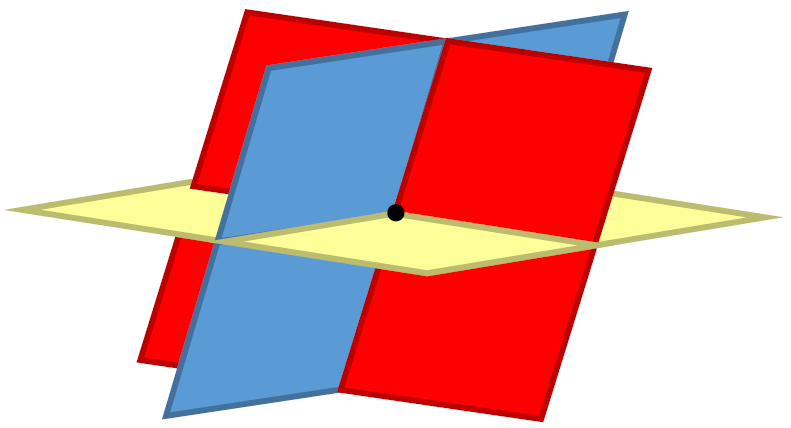
Or all three planes could intersect in one line, but then all the points on the line would be solutions. Thus, this case has infinitely many solutions.
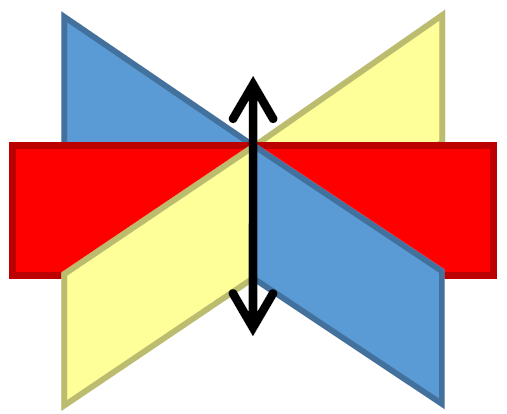
Lastly, the planes may not all intersect at any one point giving no solution.
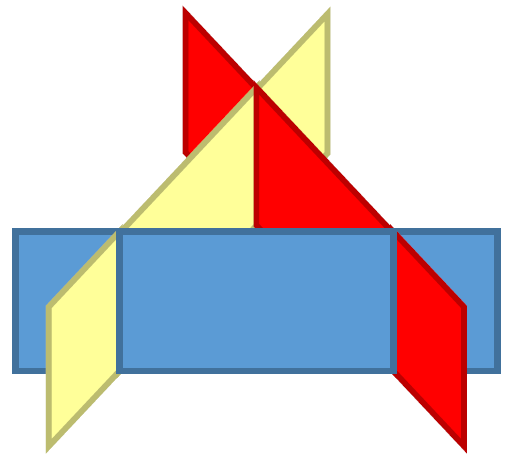
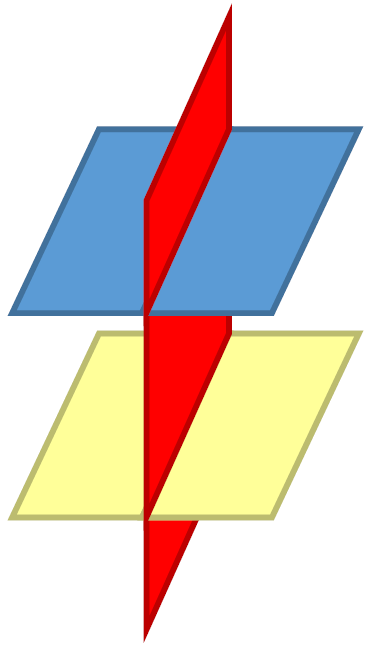
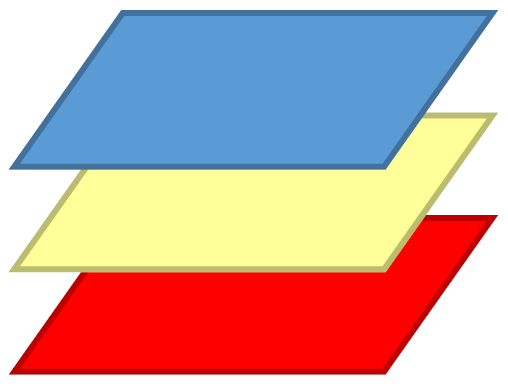
Three-dimensional linear systems can be solved by either substitution or elimination. The elimination method is usually easier for systems of linear equations, so that is what is used here. Elimination in three-variables is very much like two-variables, but it is just done more than once.
Solve a three-dimensional linear system using elimination by
Like a two-dimensional system, if all the variables are eliminated in a solving step and you get a
Solve \(\left\{ \begin{alignat}{4} 2x & + & 4y & - & 5z & = & 10 \\ x & - & 4y & + & z & = & -13 \\ -x & - & 2y & + & 4z & = & -5 \end{alignat} \right.\).
Solution
Combine first two equations by multiplying second equation by −2 to eliminate x.
$$ \begin{alignat}{4} 2x & +&4y&-&5z & =&10 \\ + -2x&+&8y&-&2z & =&26 \\ \hline &&12y&-&7z & =&36 \end{alignat} $$
The same variable needs to be eliminated when combining the last two equations. Just adding them together will eliminate x since they already have x and −x.
$$ \begin{alignat}{4} x&-&4y&+&z&=&-13 \\ + -x&-&2y&+&4z&=&-5 \\ \hline &-&6y&+&5z&=&-18 \end{alignat} $$
Now, combine the results of the previous combinations. These make a system with two variables. y could be eliminated by multiplying the second result by 2 to make 12y and −12y.
$$ \begin{alignat}{3} 12y&-&7z&=&36 \\ + -12y&+&10z&=&-36 \\ \hline &&3z&=&0 \end{alignat} $$
Finish solving this simple equation.
3z = 0
z = 0
Substitute z = 0 into one of the two variable equations such as 12y – 7z = 36.
12y – 7(0) = 36
12y = 36
y = 3
Substitute y = 3 and z = 0 into one of the original equations such as x – 4y + z = –13 to solve for x.
x – 4(3) + (0) = –13
x – 12 = –13
x = –1
The solution is (−1, 3, 0).
Solve \(\left\{ \begin{alignat}{4} -x&+&2y&+&3z&=&3 \\ 2x&+&y&+&z&=&5 \\ 4x&+&2y&+&2z&=&-1 \end{alignat} \right.\).
Solution
Combine the first two equations and eliminate a variable, maybe y this time. Multiply the second equation by −2.
$$ \begin{alignat}{4} -x&+&2y&+&3z&=&3 \\ + -4x&-&2y&-&2z&=&-10 \\ \hline -5x&&&+&z&=&-7 \end{alignat} $$
Combine the last two equations and eliminate the same variable, y. Multiply the second equations by −2.
$$ \begin{alignat}{4} -4x&-&2y&-&2z&=&-10 \\ + 4x&+&2y&+&2z&=&-1 \\ \hline &&&&0&=&-11 \end{alignat} $$
Notice all the variables were eliminated leaving the equation 0 = −11. This is a false statement, so there is no solution.
Solve \(\left\{ \begin{alignat}{4} x&-&y&-&z&=&0 \\ -x&+&3y&+&2z&=&1 \\ 2x&-&4y&-&3z&=&-1 \end{alignat} \right.\).
Solution
Combine first two equations. There is no multiplying necessary to eliminate x.
$$ \begin{alignat}{4} x&-&y&-&z&=&0 \\ + -x&+&3y&+&2z&=&1 \\ \hline &&2y&+&z&=&1 \end{alignat} $$
Combine last two equations by eliminating the same variable, x, in this case. Multiply the second equation by 2 to get −2x and 2x.
$$ \begin{alignat}{4} -2x&+&6y&+&4z&=&2 \\ + 2x&-&4y&-&3z&=&-1 \\ \hline &&2y&+&z&=&1 \end{alignat} $$
Combine the combinations. Eliminate y by multiplying the second combination by −1.
$$ \begin{alignat}{3} 2y&+&z&=&1 \\ + -2y&-&z&=&-1 \\ \hline &&0&=&0 \end{alignat} $$
Notice that all the variables were eliminated and a true statement, 0 = 0, was the result. This means there are many solutions. However, unlike two variables where the two equations were the same line, in three variables the line of intersection needs to be described.
Solve one of the reduced equations for something convenient like z.
2y + z = 1
z = −2y + 1
Now introduce a new variable. Let y = a.
y = a
z = −2a + 1
Substitute these expressions into one of the original equations to find x.
x − y − z = 0
x − (a) −(−2a + 1) = 0
x + a − 1 = 0
x = −a + 1
The solution is (−a + 1, a, −2a + 1).
If there are infinitely many solutions, the line of needs to be described. This is done by introducing a.
Sample answer (a, a + 4, 2a)
Your little brother has $1.05 in quarters, dimes, and nickels. He has twice as many dimes as quarters. He has 9 coins total. He keeps bugging you about his riches. How many of each coin do you have?
Solution
Start by translating each sentence into an equation. The first equation is the value of the money.
0.25q + 0.10d + 0.05n = 1.05
The second equation is twice as many dimes as quarters.
d = 2q
Which becomes
2q − d = 0
The third equation is the total number of coins.
q + d + n = 9
This makes the system of equations.
$$ \left\{ \begin{alignat}{4} 0.25q&+&0.10d&+&0.05n&=&1.05 \\ 2q&-&d&&&=&0 \\ q&+&d&+&n&=&9 \end{alignat} \right. $$
Start the elimination process. Because the second equation already is missing n, we can combine the first and third equations and eliminate n. Then we will have two equations with just d and q.
Multiply the first equation by −20.
$$ \begin{alignat}{4} -5q&-&2d&-&n&=&-21 \\ + \quad q&+&d&+&n&=&9 \\ \hline -4q&-&d&&&=&-12 \end{alignat} $$
Combine this with the second equation. Multiply the second equation by −1.
$$ \begin{alignat}{3} -2q&+&d&=&0 \\ + \quad -4q&-&d&=&-12 \\ \hline -6q&&&=&-12 \end{alignat} $$
q = 2
Substitute this into the second equation to find d.
2q − d = 0
2(2) − d = 0
d = 4
Substitute q = 2 and d = 4 into one of the original equations to find n.
q + d + n = 9
2 + 4 + n = 9
n = 3
Your little brother has 3 nickels, 4 dimes, and 2 quarters.
From the textbook page 32 #1, 5, 9, 15, 17, 19, 23, 43, 47, 51, 53, 55 = 12 (You can solve them all by elimination if you want.)